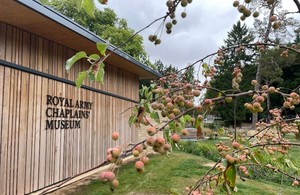Royal Army Chaplains' Museum attracts global visitors
The museum, which documents ‘Faith in the Forces’ for all branches of the military, opened its doors in May 2022.

The Royal Army Chaplains’ Museum
Boasting a number of green credentials, the museum has been attracting visitors from around the world. Previously based at Amport House in Andover, Hampshire, the museum’s new home is 36 miles away at the Defence Academy in Shrivenham in a new purpose-built facility.
The project to relocate the museum was part of the Defence Estate Optimisation (DEO) portfolio which is an ambitious 25-year investment to deliver a better structured, more economical, and modern estate that more effectively supports military capability through construction activity, unit and personnel moves, and site disposals.
To make the building as energy efficient as possible, the museum boasts innovative construction work, which included 100% carbon negative insulation and a 170m2 living green roof. During construction, over 10,000kg of local stone was used alongside a timber ‘superstructure’ which provided 69 tonnes of carbon savings: the equivalent of 38 round trips from London to New York!
Museum Curator David Blake moved with the museum from Andover to Shrivenham and speaks highly of the project:
The Royal Army Chaplains’ Museum is now housed in an eye catching, architecturally interesting and environmentally friendly building. Being adjacent to the Defence Academy of the United Kingdom, we are in a much more accessible location than we were previously and benefit from excellent transport links between Swindon and Oxford.
Officially opened by the Countess of Wessex, the Royal Army Chaplains’ Museum seeks to promote public understanding of the place and value of religion and belief in the military, showcasing exhibits and displays of wartime religious artefacts that promotes the work of chaplains in supporting the Armed Forces in conflicts across the centuries.

The Royal Army Chaplains’ Museum
Since its opening, hundreds of visitors have travelled to see what the museum has to offer. Of the wide spread of people who have enjoyed their visit, David Blake says:
We have welcomed military and civilian visitors from all over the world including Australia, USA, Kyrgyz Republic, Germany, Bosnia, Kosovo and Holland!
To strengthen ties with the local community, the museum provides a school resource by teaching students about remembrance of war and peace.
Director of Infrastructure Sherin Aminossehe reflects on the successes in relocating this important museum and all the artefacts under the Defence Estate Optimisation portfolio:
Re-providing for the Royal Army Chaplains’ Museum, and also the Armed Forces Chaplaincy Centre, involved one of the first major builds for DEO and I am delighted that the new museum is being enjoyed by visitors from across the globe.
The highly sustainable museum, that will see 60% of its energy usage coming from renewable sources, was designed to blend into its natural surroundings, taking advantage of an existing stream and local wildflowers.
The building itself is curved to support the journey of the story being told and benefits from carefully planned windows, which not only let in day-long natural light, but also allows for views out into the surrounding tree canopies, creating a sense of calm and peacefulness within the setting.
As we continue forward with the DEO portfolio, I wish this beautiful museum a long life in its new home.
The museum is open between 1.30pm and 5pm Monday to Friday and at other times by arrangement. Entry is free to the public.